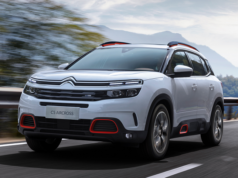There are several visual changes to the Plug-In model over the standard car that set it apart. Firstly, those cubed lighting clusters that make up the headlights are certainly a unique design aspect. A nose that is more domed provides increased aerodynamic efficiency, but some of the biggest changes are to be found at the rear. A double-bobble rear windscreen slopes downwards into a sculptural rear spoiler. It ripples in the middle and helps form a rather attractive lighting signature. Gleaming in the Spanish sun, our test car may still look unconventional, but I think its aesthetics are better than the car on which it is based.
The interior has a light airy feel thanks to large glass elements. Light roof lining lifts the cabin and contrasts with the lower elements that seemingly wrap around occupants. The dashboard is home to a central bank of screens that display everything from crucial tachometer data to graphic intensive illustrations of how the car is currently being powered. The centre console sports an 8 inch touchscreen infotainment display of which provides everything from satellite navigation to DAB radio. A wireless phone charger also featured on our test car. A pair of comfortable leather heated seats host the front occupants. The rear bench seats four with plentiful amounts of leg room, however, the sloping roof line does make headroom restrictive. Boot space stands at 360 litres, shrouded by a lightweight carbon reinforced plastic tailgate.
Total power output for the 2017 Toyota Prius Plug-In Hybrid is 120 BHP produced by a 1.8 litre petrol engine and an electric motor. The batteries have significantly improved over the last incarnation of the Plug-In Hybrid and can now power the car for a safe 31 miles. EV mode remains active at of speeds up to 84 MPH. In terms of charging said battery pack, that now takes 2 hours from a Type 2 connection, or just over 3 hours via a regular household socket. A clever battery heater makes sure that the unit is charged and discharged efficiently even at temperatures as low as -20. This car predominantly spends its time in electric mode of which provides that relaxing experience we have come to expect. The lack of engine noise boosts tranquility and at low speeds the cabin is indeed a refined place to be. Light control weights and the immediate torque that the electric motor provides is very welcome around town. On the rough patches of tarmac we did find in Spain, a cosseting suspension setup did well to cushion these imperfections. Push on and the Prius is still happy to remain on battery power and will only activate the combustion engine when extra grunt is needed or if the battery is low on power. The synergy between petrol and electric is relatively seamless and overall performance never feels lacking. On dynamic stretches of road the car does begin to show its weight as the body leans through faster bends. Heading onto a motorway isn’t an issue with reassuring progress being able to be made. Hard acceleration is met with that classic CVT groan, but driven intelligently the 2017 Toyota Prius Plug-In Hybrid is relaxing and efficient. Toyota claim that the PEV emits 22g/km CO2 and rates it at 282 MPG. Whilst the MPG figure was generated in test conditions, a colleague clocked an impressive 122 MPG combined in real word operation.
The 2017 Toyota Prius Plug-In Hybrid is a very complete package that has been the benefactor of years of evolution. This generation is the greenest yet and for those considering an upgrade, the new technology is well worth it. If you are feeling particularly eco-friendly, solar panels can be optioned for the roof to give a little extra range each day. £32,395 is a fair chunk of change when it comes to plug-in hybrids these days. That said, the Prius has become a symbol for clean motoring and owning one certainly makes a statement. This model with vast improvements over its predecessor is one of the best examples of hybrid technology in the segment.









